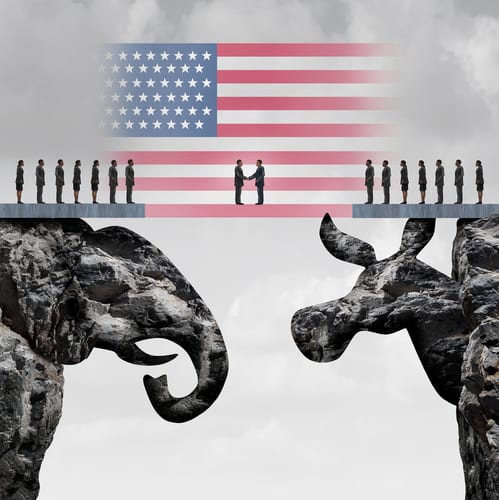
“Us-versus-them.” It’s a mentality that can make it difficult to find common ground. Lines of division are everywhere: Religion, economic disparity, race, and political identity create invisible barriers to understanding. Bringing opposing groups together is a challenge, but it’s an important task the media needs to take on. To identify the most successful means to achieve this goal, the Center for Media Engagement (CME) studied both real-world newsroom examples and academic research on the topic.
Newsroom Examples
CME analyzed 25 newsroom projects that united groups from opposite sides of the political spectrum. The projects covered a range of formats and topics such as guns, immigration, the housing crisis, and the 2016 election. Some brought participants together in person; others brought people together through closed social media groups moderated by journalists. Below is a sample of the types of projects studied for this report (see the full list here):
KUOW “Ask A…” Series
KUOW Public Radio paired up people from a variety of groups (e.g., Trump voters, immigrants, transgender persons, cops) with a partner who doesn’t usually interact with that group. In a speed-dating style event, participants paired off, talked for a few minutes, and then switched to another partner. After the event, participants felt they had gained knowledge and empathy toward the other group.
Ohio News Media and the Jefferson Center: Your Ohio Vote
Forty-two news organizations across Ohio paired with the Jefferson Center, a nonpartisan organization focused on democratic solutions and civic engagement, to figure out how to better serve communities during the 2016 election. The project brought together a group diverse in race, income level, age, and political beliefs to discuss what Ohioans considered fair election coverage. The three events resulted in in-depth reports and key takeaways to help newsrooms engage with their audience and foster political activity. After the election, the project shifted focus to another topic and became Your Voice Ohio.
Spaceship Media: The Many
Spaceship Media brought together 5,000 women from across the country with diverse political convictions. The project was conducted in a closed Facebook group where participants were asked to share personal stories, political thoughts, and policy ideas. Spaceship Media journalists moderated the discussions, which changed each week to focus on specific topics such as race or immigration. Through the conversations, Spaceship Media hoped to foster understanding between communities that may not have otherwise had the opportunity to interact with each other.
Incorporating Academic Strategies
CME also studied scholarly approaches to bringing diverse groups. The research showed that positive experiences, even brief ones, can promote tolerance, respect, and activism. Participants do, however, need to be in the right frame of mind. Asking them to imagine the other person’s experience makes them more likely to understand a different viewpoint. Emphasizing a shared background, like national identity, can also help bring them together. The research pointed to several other effective ways to bring diverse groups together:
Face-to-face
- The frequency and quality of these interactions matter.
- Superficial contact, like meeting someone on the bus, can affect attitude, but it depends on the experience.
Mediated
- A virtual meeting, like on social media, can reduce negative attitudes.
- Media exposure can make an impact:
- The quantity and quality of news portrayals can influence attitudes.
- Negative media coverage leads to negative impressions of a group. That negative impact is more lasting and more damaging than a positive impact.
Imagined
- Imagining a positive interaction with an outgroup member can reduce prejudice and alleviate political polarization.
For a deeper look at the academic research findings, click here.
Applying to the Newsroom
Bringing diverse groups together is a difficult task — and there is no one-size-fits-all answer. Media can play an important role in bridging the divide, not only through specific programs geared toward this goal, but also through coverage that sympathetically portrays opposing groups. A few key takeaways on the future of this topic:
The need to increase diverse attendance
Those who reach out or agree to participate in an event that brings opposing sides together are generally already open to hearing opposing ideas. Even participants found through a more random process have to agree to participate. To truly reach the groups that need it the most will require more creative thinking.
The need to create positive interactions
The point is not just to expose participants to a different viewpoint, but to create a lasting, positive interaction. Through their programs, newsrooms can teach people how to handle conflict, keep discussions respectful, and examine the roots of their beliefs. By asking for deeper reflection on contentious topics, they can help diverse groups understand each other.
The need for more research on the effects of these interactions
Though news projects provide anecdotal evidence, there is a need for a deeper understanding of which contexts and activities are most successful. For example, does having a communal activity, like sharing a meal, make people better prepared for a tough conversation? By continuing to study the concepts that come out of these projects, we can help newsrooms create more effective ways to bring people together.
To view the Center for Media Engagement’s full report, click here.


